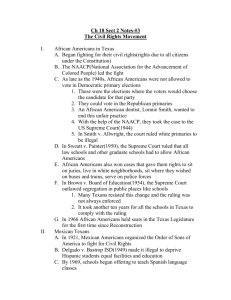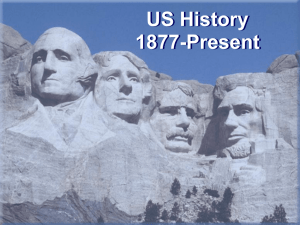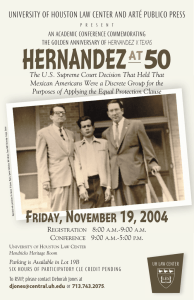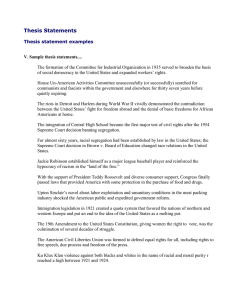Document 17795108
advertisement
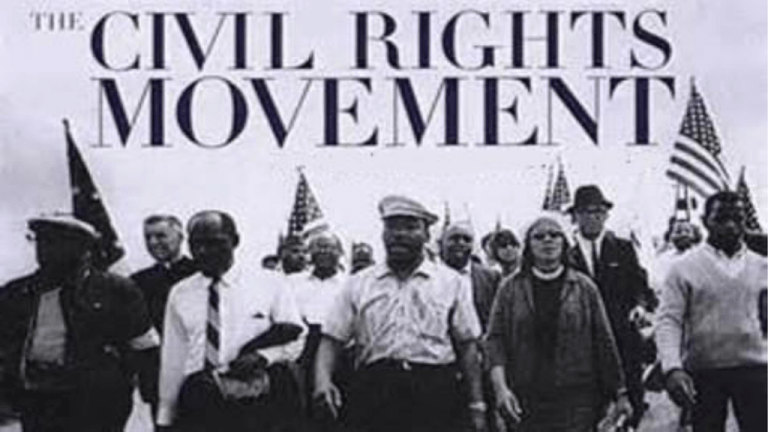
Vocabulary 2-4-15 • Students will be assigned a vocabulary word they will then create a foldable with the following: (15 Minutes) – First section: word – Second section: Definition – Larger section: a picture of the word • Must be in COLOR Group Work • You have three minutes to gather as many words and definitions as possible. Closing Task: 2/4/2014 • You will complete one paragraph, answering the following question: – Using your word as evidence, why do you believe the Civil Rights Movement is significant to U.S. History? Bell Ringer 2-5-15 • Using the vocabulary words collected in yesterday’s assignment What do you think the Civil Rights Movement is? What are Civil Rights? • Civil Rights – legal and political rights enjoyed by the inhabitants of a country. • The Constitution and Bill of Rights guarantee civil rights to citizens and resident aliens of the United States, but certain groups of people were denied some rights. • Examples of groups who have been denied civil rights include African Americans, American Indians, and women. Purpose of the Civil Rights Movement • Increase in: – voter registration and turn outs –# of minorities running for and elected into office –Laws to end racial segregation METHODS OF EXPANDING THE RIGHT TO PARTICIPATE IN THE DEMOCRATIC PROCESS Include: 1. Lobbying – the act of persuading legislators to vote for legislation 2. Non-violent protesting 3. Court decisions – court decisions can declare discriminatory laws as unconstitutional 4. Litigation –Laws must be enforced for change to occur 5. Amendments to the U.S. Constitution – amending the constitution can drastically change opportunities for participation in government (e.g., 15th Amendment, 19th Amendment). Assignment: 2/5/2015 • You will create a FLOW MAP (timeline)on the following topics: – – – – – – – Amendments 13, 14, 15 : Page 54 Amendment 19: page 124 Desegregation of the Armed Forces: Page 273 Civil Rights Act of 1957: page 275 Amendment 24: page 279 Civil Rights Act of 1964: Page 279 Voting Rights Act of 1965: Page 279 • You have to include the following for EACH!: – A date – A description of each Civil Rights Amendments • 13th Amendment – ended slavery • 14th Amendment – declared that all persons born in the US were citizens, that all citizens were entitled to equal rights regardless of their race • 15th Amendment –granted African American men the right to vote. • 19th Amendment – guarantees all American women the right to vote • 24th – eliminates poll tax Desegregation of the Armed Forces • In 1948, by Executive Order, President Truman ended segregation in the armed forces, "It is hereby declared to be the policy of the President that there shall be equality of treatment and opportunity for all persons in the armed services without regard to race, color, religion, or national origin.” Civil Rights Act 1957 • Civil Rights Act 1957 – first civil rights law since Reconstruction that primarily protected voting rights • It established a federal Civil Rights Commission with authority to: – investigate discriminatory conditions – empowered federal prosecutors to obtain court orders against interfering with the right to vote. Civil Rights Act 1964 • Civil Rights Act 1964 – abolished racial, religious, and sex discrimination by employers • It made it illegal for an employer to “fail or refuse to hire or to discharge any individual, or otherwise to discriminate against any individual with respect to his compensation, terms, conditions, or privileges or employment, because of such individual’s race, color, religion, sex, or national origin.” Voting Rights Act 1965 • Voting Rights Act 1965 – outlawed the requirement to pay a poll tax or take a literacy test in order to be eligible to vote Closing Task 2-5-15 • Students will complete an acrostic poem on the Civil Rights Movement. • This poem has to analyze, describe and depict what CIVIL RIGHTS are. • EXAMPLE: word used “ACROSTIC” Bell Ringer 2-6-15 Explain the difference between the Civil Rights Act of 1957 and the Civil Rights Act of 1964 2-6-15 Closing Task 2-6-15 • You will participate in stations and analyze each political organization. 2-6-15 NAACP • NAACP – National Association for the Advancement of Colored People • It was founded by WEB DuBois • Its mission is "to ensure the political, educational, social, and economic equality of rights of all persons and to eliminate racial hatred and racial discrimination” BPP • The Black Panther Party (BPP) had four desires: equality in education, housing, employment and civil rights. It had a 10 Point Plan to get its desired goals. • the Black Panthers had a violent method to their public stance. They preached for a "revolutionary war" but though they considered themselves an African-American party, they were willing to speak out for all those who were oppressed from whatever minority group. They were willing to use violence to get what they wanted. • The two founders of the Black Panther Party were Huey Percy Newton and Bobby Seale. LULAC • LULAC – League of United Latin American Citizens • LULAC was created to combat the discrimination faced by Hispanics in the United States • It was founded by Pedro Hernandez Barrera & Maria Hernandez AIM • The American Indian Movement (AIM) is a Native American advocacy group in the United States, founded in July 1968. • Its purpose was to encourage selfdetermination among Native Americans and to establish international recognition of their treaty rights. • It was founded by Dennis Banks, George Mitchell, Herb Powless, Clyde Bellecourt, Vernon Bellecourt, Harold Goodsky and Eddie Benton-Banai NAWSA • NAWSA – National American Woman Suffrage Association • The NAWSA was the largest and most important suffrage organization in the United States, and was the primary promoter of women's right to vote. • Founded by Susan B. Anthony, Lucy Stone, Elizabeth Cady Stanton and Carrie Chapman Catt. NOW • NOW – National Organization for Women • The NOW organization is devoted to achieving full equality for women through education and litigation. • It was founded by Betty Friedan who wrote The Feminine Mystic, which detailed the concerns of American housewives which renewed the women’s movement. UFW • The Farm Workers Movement was founded in 1962 with Cesar Chavez. • Chavez’ dream to win dignity and respect for America's farm workers through better working conditions and a living wage. SCLC • Southern Christian Leadership Conference was founded in 1957 by Martin Luther King Jr. • It was made up of AfricanAmerican clergy from the South. • It advocated nonviolent passive resistance as the means of securing equality for African Americans. SNCC • Student Nonviolent Coordinating Committee was founded by college students. • SNCC volunteers gained early recognition for their lunch counter sitins at whites-only businesses and later for their participation in historic demonstrations that helped pave the way for the passage of landmark federal Civil Rights legislation in 1964 and 1965. SNCC made significant gains in voter registration for blacks in the South. CORE • The Congress of Racial Equality (CORE) is a U.S. civil rights organization that played a pivotal role for African Americans in the Civil Rights Movement. • Founded in 1942 by James R. Robinson, James L. Farmer, Jr., Joe Guinn, George Houser, and Homer Jack. • CORE was one of the "Big Four" civil rights organizations, along with the SCLC, the SNCC, and the NAACP. Hector P. Garcia • Hector P. Garcia – Mexican American physician and civil rights advocate; Dr. Garcia organized the American G.I. Forum (1948) initially to improve veteran benefits and enhance medical attention, but it soon expanded to address educational and vocational training, housing, public education, poll taxation, voter registration, hospitalization, and employment. Closing Task 2-6-15 • In groups students will travel to different stations that analyze each political organization. You will have 8 minutes per station. Bell Ringer 2-9-15 • Which political organization believed in violence to achieve civil rights? 2-9-15 Academic Task 2-9-15 • Students will create a foldable on the following: 1. Rosa Parks- Who was she and what did she do? Page 275 2. Describe the Little Rock Incident. Page 275-276 3. Who were the Congressional bloc of Southern Democrats and what did they do? Page 277 4. George Wallace- Who was he and what did he do? Page 276 5. Lester Maddox- Who was he and what did he do? Page 276 You have 25 minutes! 2-9-15 Rosa Parks • Rosa Parks – was a African American civil rights activist • In Montgomery, Alabama (1955) she refused to give up her seat on the city bus for a white man which led to the Montgomery Bus Boycott Congressional bloc of Southern Democrats • The Congressional bloc of southern Democrats – a group of 18 southern Democrats and one Republican, worked to block the Civil Rights Act of 1964 by relying on a filibuster (delaying process) in the Senate to postpone the legislation as long as possible, hoping that support for the legislation throughout the country would fail. • Sept. 1957, school board in Little Rock, Arkansas, won a court order to admit 9 African-American students to Central High – “Little Rock Nine” – Were to attend a school w/ 2,000 white students • Gov. Orval Faubus of Arkansas orders troops from the Arkansas National Guard to prevent the students from entering the school – A mob also joins the troops to protest the integration plan & intimidate the students Crisis in Little Rock • TV coverage makes Little Rock the center of national attention – Gov. Orval Faubus used armed forces of a state to oppose the authority of the federal gov’t • 1st challenge of the Constitution since the Civil War • Pres. Eisenhower immediately orders the US Army to go to Little Rock – By morning US troops have encircled the building – Troops escort the students into school Rather than letting African-American students attend the school, Central High was shut down • “I tried to see a friendly face somewhere in the mob - someone who maybe would help. I looked into the face of an old woman and it seemed a kind face, but when I looked at her again, she spat on me” George Wallace “I draw the line in the dust and toss the gauntlet before the feet of tyranny, and I say segregation now, segregation tomorrow, segregation forever.” - George Wallace from his first inaugural address in 1963. He was a 3 term Governor of Alabama who was ProSegregation policies during the 1960s George Wallace • He received national attention when he stood at the door of the University of Alabama in a symbolic attempts to prevent 2 African American students from enrolling at that school. • (stop video at 4:23) Lester Maddox • He was a restaurant owner who refused to let African Americans into his restaurant. • He received national attention when he was threatening to hit the African Americans trying to enter his restaurant with an axe handle. • Instead of allowing Africans into his restaurant he sold it. Bell Ringer 2-10-15 • What did the Congressional bloc of Southern Democrats do? Martin Luther King Jr. 2-10-14 Martin Luther King Jr. • Martin Luther King Jr. was born on January 15, 1929, in Atlanta, Georgia. • He was a leader of the Civil Rights Movement who promoted nonviolent civil disobedience and demanded equal rights for African Americans including desegretion The Protest in Birmingham • MLK plans a protest in Birmingham, AL – He knows this will provoke a violent response – This is the only way to get JFK to support Civil Rights reform • The situation in Birmingham was volatile – After 8 days, MLK is arrested • While in prison, MLK writes “Letter From a Birmingham Jail” – Imprisoned for 11 days Letter from Birmingham Jail • “Letter from Birmingham Jail” – "There are two types of laws, just and unjust," wrote Dr. Martin Luther King, Jr., from jail in April 16, 1963. "One has a moral responsibility to disobey unjust laws" • This was similar to the Declaration of Independence, which states that a society has the right to abolish the government if it is not meeting the needs of the people. “I Have a Dream” Speech • “I have a Dream” speech – delivered at the March on Washington on August 28, 1963; • It became the mantra for many involved in the movement because it quoted the Declaration of Independence “all men are created equal…” MLK Assassinated • In the spring of 1968, a labor strike by Memphis sanitation workers drew King to one last crusade. • On April 3, in what proved to be an eerily prophetic speech, he told supporters, "I've seen the promised land. I may not get there with you. But I want you to know tonight that we, as a people, will get to the promised land." • On 04/04/1968, while standing on a balcony outside his room at the Lorraine Motel, Martin Luther King Jr. was struck by a sniper's bullet. The Shooter • The shooter, a malcontent drifter and former convict named James Earl Ray • apprehended after a two-month, international manhunt. • The killing sparked riots and demonstrations in more than 100 cities across the country. • In 1969, Ray pleaded guilty to assassinating King and was sentenced to 99 years in prison. He died in prison on April 23, 1998. Closing Task 2-10-15 • Students are to respond to the following writing prompt: –Imagine that you live in a world where people are separated based on the color of their skin (or the color of their hair, or their height, etc.). What would it be like to live in such a world? How might it change your friendships and/or your family? How would you feel? How would you respond? Bell Ringer 2-11-15 • Based on the quote, what dream is MLK referring to? Explain your answer. 2-11-14 Closing Task 2-11-14 • In a group students will create a poster on an assigned court case. (10 Minutes) • Students will then participate in a gallery walk to complete a handout on the civil rights court cases. Plessy v. Ferguson(1896) Plessy v. Ferguson(1896) – The U.S. Supreme Court ruled that states can constitutionally enact legislation requiring persons of different races to use “separate but equal” segregated facilities. • Example of Effects: Facilities such as bathrooms, theaters, railroad cars, etc., remained segregated and often unequal Brown v. Board of Education • Brown v. Board of Education – argued by Thurgood Marshall in 1954, challenged the “separate-but-equal” philosophy which fostered inadequate educational systems for African Americans. • The U.S. Supreme Court ruled that segregation in public schools was prohibited by the U.S. Constitution. Thurgood Marshall • Thurgood Marshall- a distinguished lawyer, appointed to the U.S. Supreme Court (1967) and established a record for supporting the voiceless American Mendez v. Westminster • Mendez v. Westminster – federal court case that challenged racial segregation in Orange County, California schools. • The District court held that segregating “Mexican” and “Mexican American” students into different “Mexican” schools was unconstitutional (1946). Mendez V. Westminster • In 1945,Gonzalo Mendez was not allowed to register at Westminster Main School, an all white school in Orange County, California. • In California there were separate public schools for Mexican and Latin descent children due to segregation. Mendez V. Westminster The Legal Question?? • Does segregation of Mexican-American children deny them equal protection under the law? Outcome of the Case • Case never reached the U.S. Supreme Court; California did not have a state law requiring segregation of Latino children Hernandez v. Texas • Hernandez v. Texas – U.S. Supreme Court case that decided Mexican Americans and other racial groups had equal protection under the 14th Amendment (1954). Hernandez V. Texas • In 1951, Pete Hernandez commits murder in Jackson County Texas. • The all Anglo jury that found Hernandez guilty and sentenced to life in prison. Hernandez V. Texas The Legal Question?? • Was Hernandez denied equal protection under the law because it was an all Anglo jury even though 14% of the community was of Mexican descent? Outcome of the Case • Justice Earl Warren overturned the conviction (unanimous decision by U.S. Supreme Court) because the jury was not representative and excluded Mexicans from serving on the jury. Delgado v. Bastrop I.S.D. • Delgado v. Bastrop I.S.D. – U.S. Federal District Court case that decided the separation of Mexican American children based on national origin was illegal. • It forced the integration of children in Texas schools, but did allow separate classes for the first grade only, for language deficient or non-English speaking students (1948). Delgado V. Bastrop ISD • In 1948 in Del Rio Texas, Mexican American children in various school districts were segregated into separate schools. Delgado V. Bastrop ISD The Legal Question?? • If there is no state law requiring segregation of Mexican American children and Anglo children does it violate the equal protection clause? Outcome of the Case • This case had little impact because children were still segregated based on language deficiency. Edgewood I.S.D. v. Kirby • Edgewood I.S.D. v. Kirby – a landmark case concerning public school finance and discrimination against students in poor school districts. • This Texas case led to the decision to redistribute property taxes from wealthy school districts to poorer ones (1993). Edgewood ISD V. Kirby • In 1968 in San Antonio, Texas, Demetrio Rodriguez and other parents with students in Edgewood I.S.D. argued that the division of the funds of the different school districts was unfair. • Since the division was based on property taxes not all of the schools received the same amount of money. Edgewood I.S.D. V. Kirby The Legal Question?? • Does the dividing of the funding between school districts violate the Texas Constitution in providing an efficient system of public schools? Outcome of the Case • The Texas Supreme Court ruled in favor of Edgewood I.S.D. stating that children living in poor districts had a less access to an equal education. Sweatt v. Painter • Sweatt v. Painter – a young African American man was refused admission to the University of Texas Law School. • The U.S. Supreme Court said the separation was illegal because the school was not equal due to the Equal Protection Clause. • To reach equality you must consider the quantitative differences and the intangible factors (1950). Sweatt v. Painter • The State of Texas delayed 6 months in order to create a “separate” law school in Houston for African Americans. • Later the U.S. Supreme Court overturned the Texas Supreme Court ruling allowing this action. Wisconsin v. Yoder(1972) Wisconsin v. Yoder(1972) – The U.S. Supreme Court decided Amish children could not be placed in compulsory schools past 8th grade because it violated the parents’ rights to freedom of religion (Free Exercise Clause) Effects of Wisconsin v. Yoder • Example of Effects: Prohibited states from claiming absolute right to compel school attendance beyond the eighth grade or to intrude in how families raise their children White v. Regester (1973) • White v. Regester (1973) – case in which a District Court challenged the 1970 Texas reapportionment of legislative districts. • The U.S. Supreme Court decided that the restructuring discriminated against different groups in various districts Bell Ringer 2-12-15 • What happened in the court case Plessy v. Ferguson(1896)? Great Society • Great Society – set of domestic programs designed to eliminate poverty and racial injustice. • This idea was created and enforced by President Lyndon B. Johnson. • His programs included equality of opportunity, enrichment of urban life, restoration of natural beauty, expansion of education, ending poverty, health care for the elderly and greater racial equality. Affirmative Action • Affirmative Action – refers to the steps taken to increase the representation of women and minorities in areas of employment, education, and business from which they have been historically excluded. Title IX • Title IX – "No person in the United States shall, on the basis of sex, be excluded from participation in, be denied the benefits of, or be subjected to discrimination under any education program or activity receiving Federal financial assistance..." Title IX is best known for its impact on high school and collegiate athletics. Head Start • Head Start –provides early educational opportunities for children from low income families Federal Housing Authority • Federal Housing Authority – improve housing standards and conditions; insurance of mortgages Upward Bound • Upward Bound – foster healthy development of young children from low income families Eleanor Roosevelt • Eleanor Roosevelt- First Lady, appointed by President Truman as a delegate to the United Nations General Assembly and became the first chairperson of the preliminary United Nations Commission on Human Rights Dolores Huerta • Dolores Huertaadvocate and lobbyist for farmworkers' rights Closing Task 2-12-15 • Students will create a foldable that describes each of the topics we discussed today: – – – – – – – – The Great Society Affirmative Action Title IX Head Start Federal Housing Authority Upward Bound Eleanor Roosevelt Dolores Huerta
